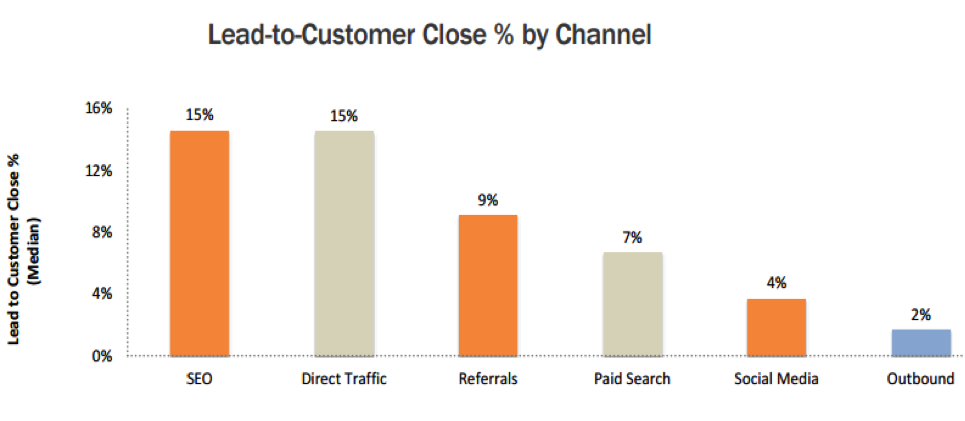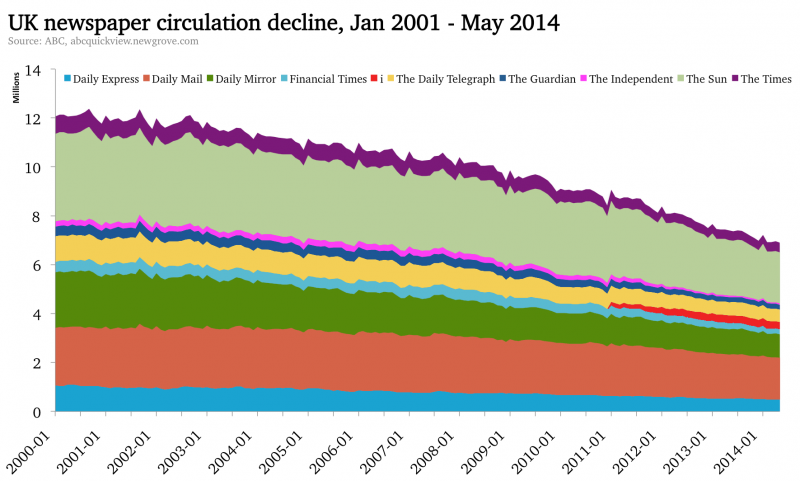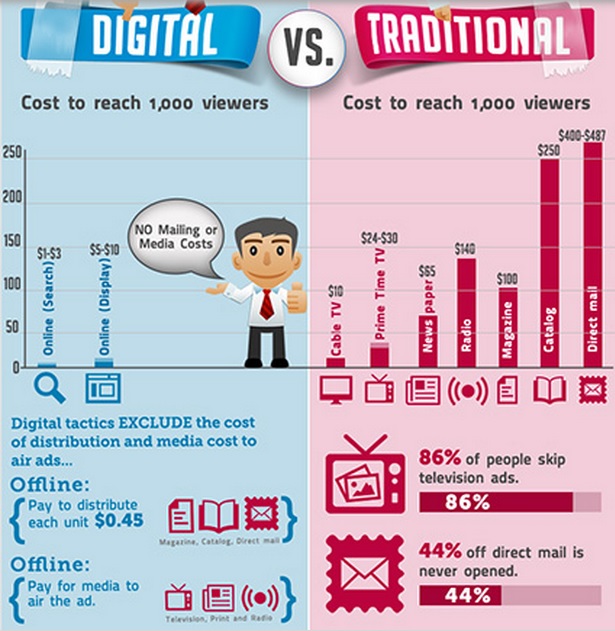
The Rise of Online Marketing, and how it’s Killing Traditional Practices
Traditional Marketing – A Declining Power
Once upon what seems like a very long time ago, prospective customers would look up your product or service in the yellow pages, miraculously remember your ridiculously expensive TV advert, or come across that coveted magazine clipping that they had been saving for this very perfect, opportune moment…
Perhaps you had to ‘cold call’ potential clients. The very term sends shivers of irritation down one’s spine. You’d barter for another 5 seconds of their time before they cut you – and any chances of your product selling – off, forever. For small businesses and marketers, these times were gloomy; traditional sales techniques were time-consuming, inconvenient and, most importantly, very expensive.
Okay, I’m painting a pretty bleak picture of traditional marketing. I would be lying if I said these techniques weren’t successful at all. They were. The key phrase here is ‘were’. Before the online boom of the 2000s, traditional marketing was just ‘marketing’. It was the status quo, and the most viable way for businesses to sell themselves.
But times have changed. In the UK, for example, the print newspaper industry is collapsing. From 2001 to 2014, newspaper sales fell from 12.06 to 6.89 million copies sold per year. That’s a 42.84% decrease!
TV advertising isn’t doing much better. Not only is it a declining market, airing a 30-second ad on national television is very, very expensive. All of these traditional marketing outlets that were once growing steady and dominating are on the out. Why? There is predominantly one reason – the Internet.
Online Marketing
What started as a small network for U.S. colleges to share data has exploded into the all-encompassing source of information and communication that we see today. As the internet becomes an ever-growing presence in our lives, so does its importance as a marketing medium increase.
When we want a product or service, the first thing that 80% of us do is search the web. 80%, 4 in 5; the vast majority. It goes without saying that, if your business doesn’t make use of online marketing effectively, you’re missing out on a huge chunk of clients. The following article will go into detail about what online marketing actually is, and the benefits it holds over the quickly declining traditional strategies of the past.
What Does Online Marketing Look Like?
Online marketing is as diverse, if not more so, than traditional marketing. However, there are a few key strategies of which every marketer should be aware:
Search Engine Optimisation (SEO)
SEO is a buzz-word that has been going around for some time, and rightly so. It is the most powerful online marketing technique that your business can utilise. Search engine optimisation, as a concept, is quite simple. Search engines – such as Google, Bing and Yahoo – find and rank web content (websites, images, videos, etc) based on a number of factors:
– The relevance and usefulness of web content
– Your website’s structure
– Your site’s loading time and responsiveness
– Number and quality of inbound (internal) links
Search engine optimisation is the enhancement of online content to appear higher up in search engine results with these factors in mind. For example, Wikipedia is a highly optimised website. This means that, for the majority of things that you search for online, Wikipedia will at least be on the front page, if not in the top 5 of results.
Two billion people browse the internet, and 93% of that number start their online journey’s using a search engine. The benefits of appearing in the first page of search results, you can imagine, are numerous, and there’s a reason why businesses hire SEO experts to optimise their content. The optimisation of content can make your business more relevant, visible and therefore much more profitable.
Social Media
With Facebook at nearly 1.4 billion monthly users alone, businesses would be foolish not to take advantage of social media outlets such as Facebook, Twitter, Linkedn and Google+. Simply having a presence one these sites and interacting with followers can have a hugely positive impact on your business. 80% of business executives ranked social media as an important tool for marketing, compared to 75% seeing it as a customer service tool. Social media marketing can:
Increase brand awareness – having a presence on social media can seriously enhance your brand’s exposure and credibility. People share, recommend and talk about brands on social media, and that fact is vital to your success in marketing online. Influence Agents talk about some seriously effective ways you can increase your brand’s awareness on social media.
Boost customer loyalty – the personal touch that social media accommodates is highly useful in increasing and securing customer loyalty. For example, the majority of Starbuck’s Twitter tweets are replies to individual customer queries. In turn, over 60% of tweets about Starbucks are positive – a surprising statistic, considering the stigma associated with the organisation. Direct interaction with customers truly boosts people’s regard of your business.
Improve traffic and conversion rates – every post, every tweet, and every share on social media is another opportunity for your readers to convert. It might simply boost traffic to your website, increasing your exposure, or entertain, engage with or inform your readers (brand awareness and loyalty) which, in turn, increases the chance that they’ll convert, and purchase your product. Fact – social media is 100% more effective at converting leads to sales than traditional marketing methods.
Content Marketing
A content-driven marketing strategy, simply put, offers your potential clients ‘value’, first and foremost. This focus on value extends to both search engine optimisation and social media. Search engines reward websites that offer informative content that provides value to readers. Similarly, quality content created/shared on social media is rewarded with the aforementioned increase in customer loyalty and brand awareness.
High-value content includes:
Infographics – long, vertical graphics that integrate statistics, facts and images in a highly readable, informative manner
Videos – video is one of the most rapidly growing mediums of communication, and will form 55% of all online traffic in 2016. A professional, informative and entertaining video that can provide value can seriously boost conversion rates
Websites – where a normal businesses website might advertise their product, a value-oriented website aims to inform, entertain, or benefit their readers. For example, WholeFoods offer valuable articles to readers on their website, who, in turn, might stick around and share it with their friends – probably on social media!
Online Marketing – 5 Reasons why it Surpasses Traditional Marketing
2. Lower Investment Costs
Sending letters to prospective clients, never mind paying for national ads, is hugely expensive, at £200 per 1000 viewers. It’s not very cost effective, either – 44% of direct mail is never even opened.
Online searches cost £0.50-£2.00 per 1000 viewers. Even if your business invests in SEO consultants, experts or services, or otherwise directs revenue towards SEO, the cost to reach 1000 viewers shouldn’t change much, as your website will experience an exponential increase in visitors. As your SEO strategy improves, your costs per 1000 visitors might even decrease!
The great, almost magical thing about the internet is that it doesn’t exist. Physically, anyway. Websites – as long as they are maintained and hosted – will remain on the web indefinitely, unlike printing costly leaflets, magazines and newspapers. Traditional marketing relies on large-cost, regular investments of money to become even comparably successful.
2. Higher Conversion Rates
Despite the higher costs, traditional marketing strategies are actually less effective. While SEO leads rake in a 14.6% close rate, traditional, outbound leads (such as direct mail or print advertising) sits at a measly 1.7%.

Search engine optimisation works on an ‘inbound marketing’ basis. That is, browsers are actually looking for your business, product or solution to their problem, which is a far more effective, client-oriented approach. Traditional marketing relies on outbound leads, which blindly hope that their target audience will be reading. For the cost, those chances typically aren’t worth it.
3. Competing is Easier
It’s true, many companies benefit hugely from traditional marketing – namely, TV and film advertisements. 96% of homes in the UK own a television set, and being able to broadcast your product to that number of viewers is invaluable. However, most of us don’t own fast food chains, or household brands, or whatever else is advertised on television these days (I haven’t switched mine on for over a year!). Most businesses are fairly small, still growing, and haven’t got hundreds of thousands in their budget for advertising.
Search engine optimisation and social media strategies are great for this. With a little effort and time, small businesses can compete with much larger companies on search engine rankings and social media presence. For the most part, Google rewards quality, optimised content, and that ‘neutrality’ is one of the most integral elements to the success of online marketing.
4. Performance is Easily Measured and Optimised
Online marketing is an analysts dream come true. With it, you can measure traffic and perform highly sophisticated tests to optimise content, all in real time. These tests allow the highest performing variable to be identified and chosen. Something as simple as a different colour, words in the headline, or font size can dramatically affect the success of online content. Everything is quantifiable, and these tweaks and changes can be performed immediately, and at little cost.
Finding the same precise information, changing even a small element of the design of a leaflet and printing a new batch is a hugely complex and costly process, involving customer surveys, test prints, and collaboration between multiple company departments that could take weeks, if not months. Not to mention the potential disaster of printing error-ridden content. Making the equivalent change to online content is ridiculously simple.
While traditional marketing often relies on word of mouth, the interconnected platform of the internet thrives on it. With appropriate content and strategies, businesses can even find themselves going viral – being viewed and shared all over the web – at no extra cost.
5. Content is Relevant and Engaging
Online marketing techniques are inherently more relevant and engaging. Browsers will find content that is relevant to their needs at the time; Google tends to rank websites from a browser’s perspective, and what online content would be most relevant and useful. Social media carries on this personalised approach, with brands being able to directly engage with their customers, cater to their needs, and reinforce brand loyalty.
85% of people fast-forward through commercials. Traditional marketing relies on one-way interruption. The majority of people simply aren’t interested in the adverts that they see. From TV ads on their favourite show to sales leaflets with the mail –traditional marketing usually forms the irritating footnotes to the prospect’s main focus or interest, and the most engagement they’ll likely get will be the salesperson cold-calling them to push their product.
Future Steps
It is evident that a paradigm shift is under way. Consumers are becoming empowered in their experience, choosing their desired brands and product on their own terms. The old ways of outbound, traditional marketing simply can’t keep up with these trends. Not only are the old forms of media – print journalism and TV – becoming redundant, intrusive forms of advertising are simply skipped or ignored. While these mediums still offer some value currently, the situation will likely look drastically different in 10, 20 or 30 years’ time.
For businesses to truly thrive, the internet is inevitable, and an opportunity for growth. This evolution towards an online-focussed marketing strategy must also come with a shift in the perception of what marketing actually does. The ‘old ways’ of pushy, loud advertising won’t survive here – the lack of comparable success of banner/sponsored adverts are testament to this.
Businesses must focus on inbound marketing techniques, where prospects are attracted towards a company’s services or products. This can only come about through the creation of quality, useful and optimised content, along with meaningful engagement with customers. It is only through this quality, customer-first’ strategy that your business will become truly future-proof.











Thanks for this article. Very useful.